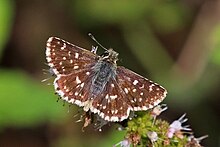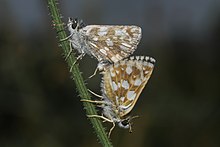A common classification of the Lepidoptera involves their differentiation into butterflies and moths. Butterflies are a natural monophyletic group, often given the suborder Rhopalocera, which includes Papilionoidea, Hesperiidae (skippers), and Hedylidae. In this taxonomic scheme, moths belong to the suborder Heterocera. Other taxonomic schemes have been proposed, the most common putting the butterflies into the suborder Ditrysia and then the "superfamily" Papilionoidea and ignoring a classification for moths.

The superfamily Papilionoidea contains all the butterflies except for the moth-like Hedyloidea.

Macrolepidoptera is a group within the insect order Lepidoptera. Traditionally used for the larger butterflies and moths as opposed to the "microlepidoptera", this group is artificial. However, it seems that by moving some taxa about, a monophyletic macrolepidoptera can be easily achieved. The two superfamilies Geometroidea and Noctuoidea account for roughly one-quarter of all known Lepidoptera.

Grass skippers or banded skippers are butterflies of the subfamily Hesperiinae, part of the skipper family, Hesperiidae. The subfamily was established by Pierre André Latreille in 1809.
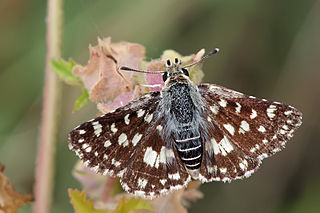
Pyrginae, commonly known as spread-winged skippers, are a subfamily of the skipper butterfly family (Hesperiidae). The subfamily was established by Hermann Burmeister in 1878. Their delimitation and internal systematics has changed considerably in recent years with the most recent review being in 2019.

Brigadier William Harry Evans was a lepidopterist and British Army officer who served in India. He documented the butterfly fauna of India, Burma and Ceylon in a series of articles in the Journal of the Bombay Natural History Society. Brigadier Evans was especially interested in the taxonomy and systematics of the butterfly families Lycaenidae and Hesperiidae an example being his A revision of the Arhopala group of Oriental Lycaenidae Bull. British Mus. , Ent., vol. 5: pp. 85–141 (1957).

Oriens concinna, the Tamil dartlet, is a skipper butterfly belonging to the family Hesperiidae. It is a rare find in India and Australia. In India, it is found in Kerala, Tamil Nadu and Karnataka.

Hedylidae, the "American moth-butterflies", is a family of insects in the order Lepidoptera, representing the superfamily Hedyloidea. They have traditionally been viewed as an extant sister group of the butterfly superfamily Papilionoidea, but a 2014 phylogenetic analyses has suggested Hedylidae is a subgroup of Papilionoidea, and not a sister group, and are more accurately referred to as butterflies rather than moths. They are represented by a single Neotropical genus Macrosoma with 35 currently recognized species.
Butterfly evolution is the origin and diversification of butterflies through geologic time and over a large portion of the Earth's surface. The earliest known butterfly fossils are from the mid Eocene epoch, between 40-50 million years ago. Their development is closely linked to the evolution of flowering plants, since both adult butterflies and caterpillars feed on flowering plants. Of the 220,000 species of Lepidoptera, about 45,000 species are butterflies, which probably evolved from moths. Butterflies are found throughout the world, except in Antarctica, and are especially numerous in the tropics; they fall into eight different families.

The Ancistroidini are a tribe in the Hesperiinae subfamily of skipper butterflies. They are often blackish in base color; several of the genera contain the species commonly called "demon butterflies" or "demon skippers". As most Hesperiinae have not yet been assigned to tribes, more genera are likely to be placed into this presently rather small group eventually.

Trapezitinae is a subfamily of the Hesperiidae ("skippers") family of butterflies. They are found only in New Guinea and Australia. The subfamily contains about 60 species in 20 genera.
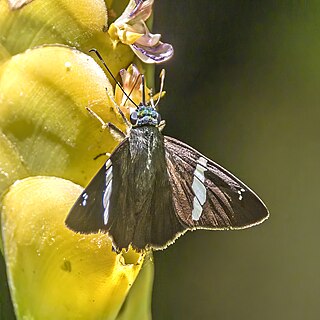
Autochton is a genus of skipper butterflies. They belong to the subfamily Eudaminae, which was long included with the spread-winged skippers (Pyrginae) as a tribe. They are found from Mexico to South America.

Agathymus is a genus of butterflies in the skipper family, Hesperiidae. They occur in the North American deserts. The genus was described by Hugh Avery Freeman in 1959. The larvae bore into the stems of agave plants.

Dalla is a genus of skippers in the family Hesperiidae.
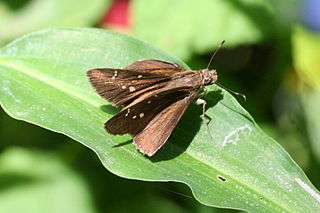
Decinea is a Neotropical genus of skippers in the family Hesperiidae.

Heliopetes is a Neotropical genus of spread-winged skipper butterflies in the family Hesperiidae.
Pamphilites is an extinct genus of skippers in the family Hesperiidae. It contains only one fossil species, Pamphilites abdita, recovered from the Tertiary of Aix-en-Provence, France.
Piruna is a genus of skippers in the family Hesperiidae.

The Carcharodini are a tribe in the skipper butterfly subfamily Pyrginae. They are a very diverse but quite plesiomorphic and inconspicuous group distributed throughout the tropics.

The Erionotini are a tribe of skipper butterflies in the subfamily Hesperiinae.



